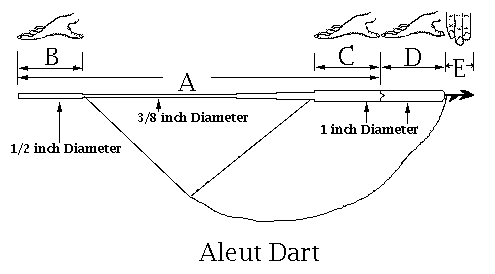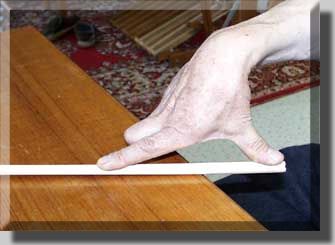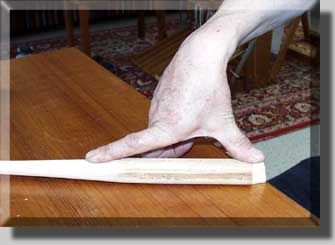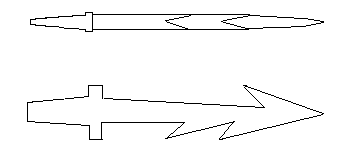
The Aleut Sea Otter Dart is a wooden shaft with a bone fore shaft lashed to its end, and a bone projectile point secured to the end of the fore shaft. The bone projectile point is tied with line that attaches to a bridle secured to the wooden shaft of the dart. When the dart strikes a Sea Otter, the bone point separates from the dart, and the drag of the dart shaft slows the Sea Otter in the water. Then the hunter in a kayak can chase down, and dispatch the animal.
This information was originally from Bill Tcheripanoff born in Unalaska and resided in Akutan, he died in 1982. Bill passed this information on to Emil Berikoff. Emil is still making darts and throwing boards, and is happy to teach it to anyone interested.

A. The Aleut darts wooden shaft length is found by
holding the end of the shaft in your hand and stretching your arm out to its longest
reach. Then look away from that arm as far as possible and mark the shaft at your
nose This arm to nose stretch will give you your own personally fitted dart, this
will also match up to your custom fitted throwing
board.

Emil Berikoff demonstrates arm to nose stretch
measurement to get correct length for
the wooden shaft of Aleut Dart.

B. The darts end,
the part that fits into the throwing boards notch, should be carved
down to to about 1/2 inch diameter for the the length of one (1)
finger stretch. Beyond the distance of the stretch length the dart
shaft will taper down to 3/8 inch diameter. The 3/8 inch diameter
will extend foreword about 1/3 the length of the shaft, then slowly
increase in diameter to meet the 1 inch end of the shaft.

C. The straight 1
inch diameter of the shaft is one (1) finger stretch from the end of
the shaft, including the V-notch that fits into the fore shaft.

D. The fore
shaft is attached to the 1 inch end of the wooden shaft. The fore
shaft's length is one (1) finger stretch. The join point of the fore
shaft and the wood shaft is carved into a V-notch, and lash with
sinew or leather. The fore shaft is caved so its middle is 3/4 inch
diameter with the ends being 1 inch diameter, it taper's cleanly in
both directions. The fore shaft is fitted into the V-notch of the
wooden shaft at one end, and a bone projectile point is fitted into
the end of the fore shaft at the other end.

E. The bone
projectile point's length is measured with the width of the first
three (3) finger side by side. This length does not include the
socket where the point has to fit into the fore shaft.

F. The finished
dart is fitted with a line bridle that attaches to the bone
projectile point. The line and bridle at rolled on to the dart and
fore shaft and the line is tucked under its self to hold the bone
projectile point in place. Examples in museums have birch bark paper
under the line where it was attached to the wooden shaft, and also
under the lashing that holds the fore shaft to the wooden shaft.
Note: The bone from a Whale's lower jaw is considered the best
for the making fore shafts, and projectile points. it is very dense
and can be polished to a high luster.
- VOLCANO OBSERVATORY -|- UNALASKA CITY SCHOOL -|
|-
Williwaw Weather Links
-|- Unalaska Methodist Church-|
|-MUSEUM OF THE
ALEUTIANS - |- UNALASKA
VISITORS BUREAU-|
|-WORLD ATLATL
ASSOCIATION -|- HOLY
ASCENSION OF OUR LORD CATHEDRAL UNALASKA-|
|-UNIVERSITY
OF ALASKA FAIRBANKS -|-CITY
OF UNALASKA -|

![]()